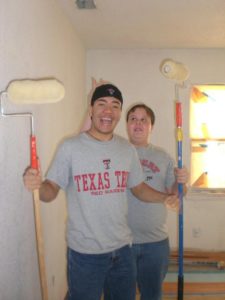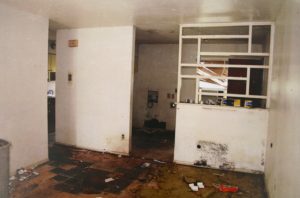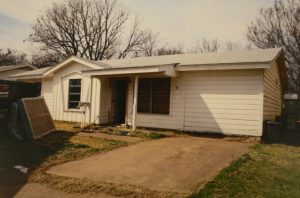6 Stones: An Oral History
PART II – Community Powered Revitalization (CPR)
GARY MCKAMIE, City Manager, City of Euless (2007 – 2015):
“It was probably about January of 2008. Remember that time-frame: 2008 was the beginning of a recession in our country. A serious, serious recession that hit housing badly. I got a call that [First Euless] Pastor John Meador and Scott Sheppard — who was on staff here at the time — wanted to have lunch and talk about what the church might could do for the city. Honestly, my first thought was that we’d been down this road before… [but] John Meador, Scott Sheppard, our State Representative at the time Todd Smith, and Gary Phillips — Gary was the business administrator at the time, here at First Euless — and me, we had lunch; had a nice conversation about things that were going on in the community. Things that were going on nationally and in the world.”
“There was a discussion along the lines — which we’d had several discussions on — of providing shoes for children that didn’t have shoes. School Supplies. Meet with city employees to share the Gospel and to counsel. All sorts of things that really are important, but they weren’t necessarily anything that, as City Manager, that I had a great deal of interest in participating in at the time. Somewhere during that meeting, Gary Phillips asked the question: ‘What if we wanted to do something much bigger than this?’ The key two words in that question was ‘What If…’ and they really were two words that were kind of part of our thesis in the years to come. I don’t know that anyone had ever asked me that question… and I didn’t have an answer at the time.”
JOHN MEADOR, Pastor, Cross City Church (2006-Present):
“I think Gary was pleasantly surprised — and probably pleased — that we were asking that question. Gary himself had a tremendous passion for the city, wondered how he could better impact the citizens from his role as City Manager, but had probably never been asked by a church: ‘how can we come alongside you and help accomplish that vision that you may have, but you need some volunteers to help bring certain things about?’ His suggestions seemed to come from the mind of a man who had thought about that before. We just hadn’t bothered to ask him the question!”
MCKAMIE: “The City Code Enforcement Officers… were hamstrung in that City Management put pressure on them to get things done. The community put pressure on me to get things done. But the truth of the matter is that the Code Enforcement officers had nothing with which to help people, other than writing a ticket. Which costs money. They didn’t have the money to fix their house, so they sure didn’t have money to pay a ticket. At any rate, the City was at the time — and I think they still are — involved in a Federal Grant program through Tarrant County Community Development. It was a HUD program, a Housing and Urban Development program, called HOME. Tarrant County HOME, locally.”
“There was money pledged by HUD to do major renovation of houses, and the City had to match a portion of it. So HUD, through Tarrant County Community Development, had money budgeted to do major renovations of homes. The City had match funds set aside to do the city’s match on those programs. But there was very little movement. It was a very, very long, hard process to get a house qualified and to get the work in progress. So that money that Tarrant County had available through HUD and the money the City had allocated was really just sitting there. So the conversations turned from tennis shoes and school supplies to ‘what could we do about housing?’”
“We didn’t do extensive research. That’s probably something Scott Sheppard and I had in common; we were both a little prone to fly by the seat of our britches. So we didn’t go out and find examples that we could follow. The concept of separation of Church and State was always a concern: that someone was going to come in and say, ‘no, you can’t do this.’ I think I probably expected that on a daily basis… there are people that are opposed to using tax dollars to assist someone. We had to find a legal avenue by which we could achieve that. We did that pretty quickly through the agreements that we had; the City Council of a city can declare a project to be a benefit to the larger community and they can invest tax dollars in that. There was this concept that everyone could benefit from it. The City benefited from the improved property values and the anticipated effect that if you fix this one house up, the two houses on either side of it will be fixed up. You’ll start getting a neighborhood fixed up. The Churches were able to witness; to show people the love of God. Businesses were able to contribute to something that they could really see the outcome of.”
MEADOR: “The problem-solving skills of a Gary McKamie — or Dr. Buinger a little later on — were amazing. How do you navigate this? A faith-based organization who wants to help in a way where a City Official or School Official has to find their way around that. These guys were willing to do that. Some may not be, but these guys were. And I think that was the key.”

Early home restoration projects were more extensive because small teams and projects made it easy to guarantee safety and quality. As the program grew, it shifted to focus on exterior repairs.
MCKAMIE: “I’m not sure what took place from the church’s side; I know what took place from the City side: that was an examination of whether we could utilize city resources that were designated for this match to the Federal Grant program. And, in some cases, could the Federal Grant money be utilized to help with homeowners that were struggling? Very quickly, there was a decision made that we didn’t know exactly the pathway to get it done, but we believed there was a pathway. The best way to find our way through that was to just start. At that time, there was no program. This was just kind of an agreement between friends that there was a need and we were going to start. So the City’s Code Enforcement officers began to look — rather quickly — for a house that might be an example of what we needed to be working on.”
JIM PACK, Missions Pastor, Restoration Church (1998-2012) / 6 Stones Board (2009-2013):
“When 6 Stones was coming into existence, our church was doing the same thing as Euless First. At that time, we were visiting with city leaders, studying about how to minister in your city, how to become a part of the city that you live in. Before you could reach out around the world — like we were doing — you needed to reach out at home! We had a care ministry like they had a feeding ministry here, but we wanted to see if we could expand that. So we were looking into where we might fit. We were interviewing with the Police and the Mayor, the City Manager and Fire Department. We were going around trying to figure out what we could do; what did they need?”
MCKAMIE: “We found two things. Number one, we found a home that was already being worked on by a church that’s no longer here, called Restoration Church. It was at Wilshire and Highway 10. There was a very passionate group of people there, led by Ken Harp and Jim Pack. We learned that they were remodeling this house in the Wilshire Neighborhood in Euless. It was in a pretty nice neighborhood, but it was a horrible situation. Roach infested to the extent that you could not go in the house that you didn’t get roaches literally on you. It was thousands and thousands of roaches.”
“The other home that was identified was a home that was on Freestone, in the Midway Park addition in Euless. It was two sisters whose parents had passed away and left them the house. They were both disabled; one of them totally disabled and the other one, partially disabled. It was a small-frame house in, probably, about as bad of conditions as you could find in a metropolitan area that was at the time still supposed to be somewhat of an affluent area. There were water leaks everywhere; around the bathtub area, there was really no sheetrock. It had gotten so wet that it had fallen. There was water coming out of electrical sockets. The roof leaked. It was just pitiful. Scott Sheppard looked at that home and said ‘yeah, that’s something that we could do.’”
MEADOR: “Probably the most humbling thing about that first house and that first situation was that Gary gave us an address of a home that we went and kind of scoped out. At this point, it was primarily Scott and our staff at First Euless that were working on that. But it turned out to be our own church members’ home, below code. Two single sisters. It had plumbing problems. I remember in January, it was icy. Water had been spilling from a sink or a drain. It was one or two inches deep on the floor of the bathroom, and it was frozen. And they lived there. They were our church members, and we didn’t know about it. Super humbling… we have all these resources, and here are people we know, who worship with us every week, and we didn’t know their need. I can understand why they wouldn’t share that freely, but we wanted to help.”
MCKAMIE: “I think God probably got a pretty good kick out of this because there’s no doubt in my mind, He planned it this way: both the owners of those homes were members of First Baptist Euless. One of them was an Army veteran. The two ladies at Midway Park, one of them could not work and the other one worked at McDonalds, which was about a mile and a half, two miles away. And she walked every day. She walked to work and she walked home. She was a member of our church here, but she had just kind of been forgotten. Not by the church, but by everyone. They just existed in this house in absolutely deplorable conditions.”

Gary McKamie recalls the first ER home as one in which no human being should live because of extensive water leaks.
“There was an agreement that we would work on this house: the ‘we’ was primarily Scott. Scott had construction experience, and he and his dad, Doyle Sheppard, did the lion’s share of that work. It was a total remodel, inside and out… it took a few months, but it was a huge effort. City employees helped, as well. John Meador was on the roof, roofing at times. Everyone from every level of the church and the city threw in to help this. And you had the same thing going on in Wilshire with Restoration Church.”
MEADOR: “It was a funny thing to watch a worship pastor that had never been on a roof before — didn’t know how to swing a hammer — on the roof. I think I was more worried about him falling off than anything else. The shingles we put on that roof, as we completely re-roofed it, were not straight. They’re not straight to this day, but they cover the roof. It was our first attempt… but the gratitude of those sisters was off the charts. It was fuel for our fire. We can make a difference in our community, starting with someone we know.”
MCKAMIE: “When that house was started, I wasn’t even sure that I would see the end of that work because it was such a disaster. It was begun in the spring. During the bad weather, we had the roof off of it. All kinds of horrible things occurred. But God came through, just like He always comes through. Churches began to work together. Businesses began to pitch in, to contribute. They contributed workers, they contributed materials, they contributed money. It was nearly like this wonderful time where you had all these needs hanging out, and you had all these people that were willing to help. But the dots couldn’t be connected… within a relatively short time, all of that was pulled together. It wasn’t pulled together by John Meador. It wasn’t pulled together by Scott Sheppard or anyone else. It was pulled together, in my mind, by the Lord.”
PACK: “I was the only guy that John or any of them had ever known that was on the Board — I was the Vice President of the Board for 6 Stones, as it turned out — and not a Baptist. I was the Missions Pastor at Restoration Independent Church. There was always a lot of laughs about that. When Restoration started back in ‘83, a large number of people came from this church and went there… for years, there was some bitterness.”
“It all really generated out of those meetings where Gary McKamie and the City Staff was realizing that, if certain things didn’t happen, they would be a city in decline. Houses can be correlated to a community starting to go downhill. So that was an important part. We could bring streets back up to looking like they were well kept. We could fix houses where people were too old or not capable, financially or physically, to keep up their homes.”
“Gary McKamie made a great statement one day. He said ‘I could say no every time you come in here. But I choose to say yes. We’re going to say yes until we get to someplace where we can’t. So I’m going to be thinking yes and hoping we never have to say no.’ That evolved, we got the County Commissioner involved. His organization was providing funds, the City was providing funds. Eventually, Bedford and Hurst came online and the program merged into their cities. It became a very positive event; everybody looked forward to it. It gave the leaders in the cities, churches, and businesses a chance to go out and get involved and immersed in the city… the more it went, the more creative it got. And the more creative it got, the more needs were met. That program will be going until this doesn’t exist anymore.”

Early on, it was essential for every sector of the community to have a clear role and benefit of involvement in 6 Stones programs.
MCKAMIE: “It was really rough times, economically. There is so much distrust between churches and government. Between different denominations of churches. But out of all of that doubt and troubled times, the Lord was answering the question ’What If?’ I think the ‘What If?’ question, to a believer, simply meant ‘we’re going to rely on the Lord because we can’t do this.’ Some of the need was simply to bring churches together and to show this community that churches care. Churches care about people that they’ve never laid eyes on. They may never lay eyes on them again. But they care. And that’s nothing more than following the teachings of Jesus. Jesus gave us hope, and 6 Stones came to be the hands and feet of Jesus in this community; to bring hope where there was no hope at times, for some people.”
PACK: “We would emphasize with the teams to represent yourself well there. We accomplish nothing if we get the job done and you guys have been fighting on the job site. So we established Site Captains and Site Leaders so that everybody understood from the very beginning that this is the person who says the final ‘Yes' or the final ‘No.'”
MCKAMIE: “It went from zero to sixty pretty quickly… we had to learn processes. We had to learn capacity. That was the key part of it. All of this costs money. It takes time. We had to learn what capacity everyone had to get it done. And at the time, there was a huge inflow of requests because the need was enormous. So we had to manage the resources to get it done.”
MEADOR: “This can happen wherever people are listening to God about the needs of the city… we’ve got an incredible foundation of things that God has done, and I’m extremely confident that He’s going to keep building on that. Because it’s not really something that we could have put together ourselves. And when God opens a door, nobody can shut it. I believe that with all my heart. He opened this door, He opened people’s hearts. He’ll keep doing it. I’m looking forward to the next chapter. I’m looking forward to how many people are going to learn about this for the first time or be impacted by this for the first time.”

